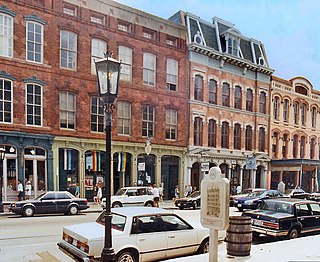
The Strand Historic District, also known as the Strand District, in downtown Galveston, Texas (USA), is a National Historic Landmark District of mainly Victorian era buildings that now house restaurants, antique stores, and curio shops. The area is a major tourist attraction for the island city and also plays host to two very popular seasonal festivals. It is widely considered the island's shopping and entertainment center. The district includes properties along the south side of Harborside Drive and both sides of The Strand and Mechanic Street from 20th Street westward to 26th Street.
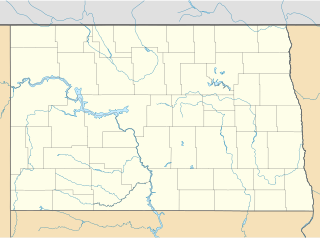
Downtown Grand Forks is the original commercial center of Grand Forks, North Dakota. Located on the western bank of the Red River of the North, the downtown neighborhood is situated near the fork of the Red River and the Red Lake River. While downtown is no longer the dominant commercial area of the Greater Grand Forks community, it remains the historic center of Grand Forks. An 80.4-acre (32.5 ha) portion was listed on the National Register of Historic Places in 2005, as Downtown Grand Forks Historic District. Today, downtown Grand Forks is home to many offices, stores, restaurants, and bars.

Downtown Norfolk serves as the traditional center of commerce, government, and culture in the Hampton Roads region. Norfolk, Virginia's downtown waterfront shipping and port activities historically played host to numerous and often noxious port and shipping-related uses. With the advent of containerized shipping in the mid-19th century, the shipping uses located on Norfolk's downtown waterfront became obsolete as larger and more modern port facilities opened elsewhere in the region. The vacant piers and cargo warehouses eventually became a blight on downtown and Norfolk's fortunes as a whole. But in the second half of the century, Norfolk had a vibrant retail community in its suburbs; companies like Smith & Welton, High's, Colonial Stores, Goldman's Shoes, Lerner Shops, Hofheimer's, Giant Open Air, Dollar Tree and K & K Toys were regional leaders in their respective fields. Norfolk was also the birthplace of Econo-Travel, now Econo Lodge, one of the nation's first discount motel chains.

The Bank of Bigheart is a historic commercial building in the town of Barnsdall, Oklahoma. It originally housed the first bank in Barnsdall, which was originally named Bigheart, Oklahoma. The building was added to the National Register of Historic Places on November 23, 1984.

The Moritz Bergstein Shoddy Mill and Warehouse are two historic industrial buildings in Stillwater, Minnesota, United States, in which Jewish German immigrant Moritz Bergstein conducted a recycling business circa 1890 to 1910 providing materials for mattresses. They were originally built in Oak Park Heights, Minnesota, around 1890 and were moved to neighboring Stillwater in 2012 to make way for construction of the St. Croix Crossing bridge. The property was listed on the National Register of Historic Places in 2008 for having local significance in the themes of industry and social history. They were nominated as a rare surviving embodiment of Minnesota's early Jewish immigrants and their frequent participation in the waste materials trade.

The Main Street Historic District in Lake Geneva, Wisconsin is a 2.5-acre (1.0 ha) historic district that was listed on the National Register of Historic Places on January 11, 2002. The listing was amended in some way in a revised listing on March 5, 2002. In 2002, there were 20 buildings in the district that were deemed to contribute to its historic character.

The downtown district of West Branch, Iowa is part of the West Branch Commercial Historic District. Multiple architectural styles are represented. The historic and endangered Gruwell and Crew General Store is also part of the district.
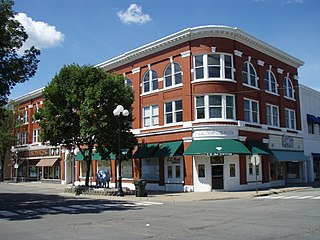
The Parker Building is a historic commercial building located in Brainerd, Minnesota.
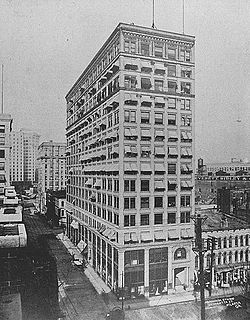
The J. Mack Robinson College of Business Administration Building is a 14-story highrise at the corner of Broad and Marietta streets in the Fairlie-Poplar district of downtown Atlanta, which houses the business school of Georgia State University. When completed in 1901 as the Empire Building, it was the first steel-frame structure and the tallest in the city, until surpassed by the Candler Building in 1906.
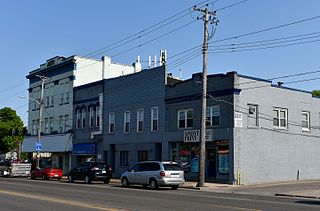
The College Corner Commercial Historic Business District, also known as the Highland Park Historic Business District at Euclid and Second, is located in the north-central section of Des Moines, Iowa, United States. It is located in the Highland Park neighborhood that also includes the Highland Park Historic Business District at Euclid and Sixth Avenues. The College Corner historic district has been listed on the National Register of Historic Places since 1998.

Mount Pleasant Historic District is a national historic district located at Mount Pleasant, Westmoreland County, Pennsylvania. It encompasses 268 contributing buildings, 1 contributing site, and 1 contributing object in the central business district and surrounding residential areas of Mount Pleasant. They were built between about 1812 and 1948, and includes a mix of residential, commercial, institutional, and industrial properties. They are in a variety of popular architectural styles including Italianate, Queen Anne, and Colonial Revival. Notable buildings include the Overholt General Store, harness shop, warehouse, East End Hotel, Grand Central Hotel, Gerechter Furniture Building, Citizens Savings and Trust Company and First National Bank (1905), Shupe Steam Grist Mill (1843), City Hall (1910), Penn Theater (1937), Reunion Presbyterian Church (1873), Wesley United Methodist Church (1856), Transfiguration Roman Catholic Church (1889), and three houses built about 1812. The contributing site is Frick Park. The district includes the separately listed Samuel Warden House and demolished Mount Pleasant Armory.
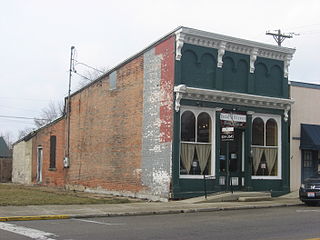
The Village Hobby Shop is a historic building in the village of Mechanicsburg, Ohio, United States. Built on Main Street in the late 19th century, it is one of the village's oldest extant commercial buildings, and it has been named a historic site.

The Hoke Building is one of the original commercial buildings in the downtown area of Stillwater. It provided easy access to the Courthouse, and has housed attorneys, judges, dentists, insurance companies, and an abstract company. Space was provided to students at Oklahoma State University for dances and other activities.

Market House Square District is a national historic district located at Fayetteville, Cumberland County, North Carolina. It encompasses 11 contributing buildings in the central business district of Fayetteville. The district includes six storefronts and a major store, an office building, a former Knights of Pythias Building, and the First Citizen's Bank Building, all of which date between 1884 and 1926 and ring the separately listed Market House. The First Citizen's Bank Building was designed by architect Charles C. Hartmann and built in 1926.
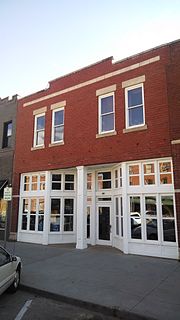
The Walker Building is one of the original buildings in the downtown area in Stillwater. Built in 1914, it is a two-story red brick, 32 feet wide. The ground floor is 88 feet deep with a 10-foot passageway in the rear covered by a loft and a second story which is 100 feet deep.

The Selph Building is one of the first commercial buildings to be built in the downtown area of Stillwater, Oklahoma.
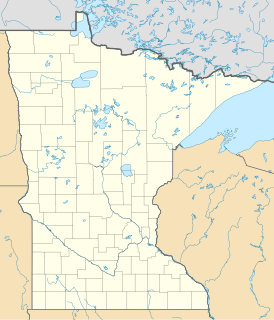
Isaac Staples' Sawmill is a historic industrial property in Stillwater, Minnesota, United States, consisting of an 1850 stone powerhouse and a 1900 metal-clad factory. The property was listed on the National Register of Historic Places as St. Croix Lumber Mills—Stillwater Manufacturing Company in 1982 for its local significance in the theme of industry. It was nominated because the powerhouse is the only surviving industrial building associated with Isaac Staples (1816–1898), a major figure in Minnesota's early commercial development. The property now operates as a shopping mall with upper level apartments.

Downey Savings Bank is a historic building located in the unincorporated community of Downey, Iowa, United States. The bank was charted and this building was constructed in 1903. The two-story, brick building is an example of an early twentieth century commercial bank building. At the time it was built the town had several other businesses. The bank continued in operation until 1932 when it was closed during the National Banking Holiday. Because its capital was not large enough to meet the new federal banking regulations it was consolidated with the West Liberty Bank. John Bashor opened a grocery-hardware store in the building in 1935, and operated it here until 1961. The building housed a grocery store from 1961 to 1972. After an attempt to convert it into a pool hall and cabinet shop, it became a pottery in the mid 1970s. The building was listed on the National Register of Historic Places in 1976.
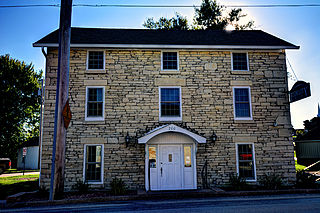
Harris Wagon and Carriage Shop is a historic industrial/commercial building located in La Motte, Iowa, United States. It is one of over 217 limestone structures in Jackson County from the mid-19th century, of which 20 are commercial/industrial buildings. The three-story structure was built in 1871, possibly for Levi Hutchins. It is also possible it was built for the Will and F.R. Harris Wagon & Carriage Shop, which was located here. There was some difficulty identifying the original owner. Over the years the building has also housed a harness shop, a hardware store, and a feed and farm supply store, before becoming a bank in 1982. The stone blocks that were used in the construction of this rectangular structure vary somewhat in shape and size, and they were laid in courses. The window sills and lintels are dressed stone. It features a symmetrical, three bay facade. The building was listed on the National Register of Historic Places in 1992.























